 |
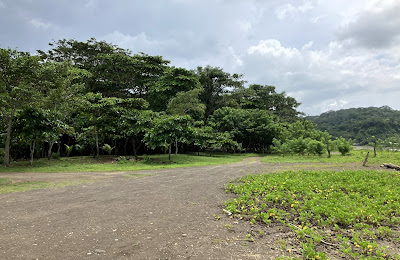 |
| Scarlet Macaw habitat - Beach Almond trees at Tarcoles |
 |
| First sighting of a Scarlet Macaw - Tarcoles, Costa Rica |
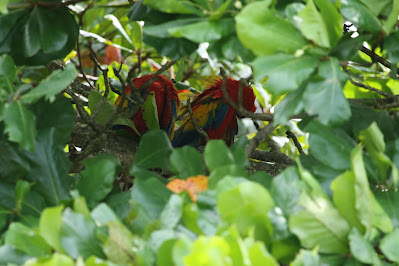 |
| Scarlet Macaws blending in |
 |
| Scarlet Macaws getting friendly |
 |
 |
| Scarlet Macaw habitat - Beach Almond trees at Tarcoles |
 |
| First sighting of a Scarlet Macaw - Tarcoles, Costa Rica |
 |
| Scarlet Macaws blending in |
 |
| Scarlet Macaws getting friendly |
 |
| A wet afternoon at Centro Manu reserve |
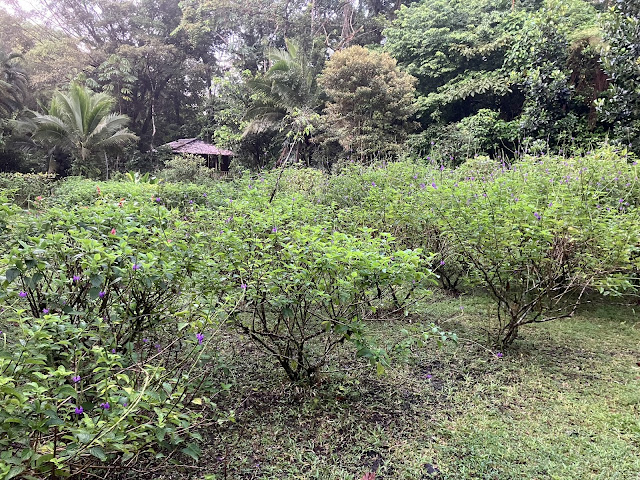 |
| Centro Manu - the hummingbird garden |
%2015.10.24.JPG) |
| Rufous-tailed Hummingbird (from Pocosol) - a bit of a bully! |
 |
For many, the Resplendent Quetzal Pharomachrus mocinno is the poster bird for Costa Rican eco-tourism, the undoubted number one. Clad in vivid, metallic green plumage with an unfeasibly long tail dangling below, the male quetzal is high on the tick list of tourists and birders alike. And it's a more dramatic bird than my dodgy photograph (above) might suggest, although the sight of this luminous male glimpsed through a gap in the foliage was an exciting moment.
While Costa Rica may be the best place to see one, the Resplendent Quetzal occurs along the spine of Central America from the south of Mexico to western Panama. In Guatemala it has given its name to the national currency, the story being that in the days of Mayan civilisation its tail feathers were used as money. The quetzal is a bird of high elevation rainforests, generally found above 900m (3,000 feet). It can turn up in suitable forests all along Costa Rica's central mountain chain, including the well-known Monteverde reserve, but is perhaps best searched for in the south of the country - and where else but the Parque Nacional Los Quetzales?
Or nearby, at any rate. Our first quetzal encounter was in the neighbouring Dota Valley, an area that I introduced in my Collared Redstart blog (link here). We were walking on a trail across the valley from Miriam's Quetzals restaurant (a hopeful sign!), when our guide Pat O'Donnell (link to his website here) heard a quetzal calling - a sound with more than a hint of car alarm in it. Pat responded with an impressively accurate response and the bird moved slightly closer, allowing us to get a distant glimpse through the intervening leaves. I snapped a few record photographs before it flew: and with some misgivings, I've included one of these below. Bear in mind that this was the best of a bad bunch. It serves as a salutary reminder that birding in tropical forests can be difficult, and good views of birds can never be guaranteed. It makes it all the sweeter when it happens, of course.
%20Dota%20Valley%2024.19.24.JPG) |
| Spot the quetzal! Terrible record photo of our first sighting. |
Although we were pleased to see one, our first quetzal encounter was a bit underwhelming. That's the problem with building up expectations. However, there was better to come. While birding along the unsurfaced road that drops steeply down to Providencia (see the Collared Redstart blog), and within the national park this time, we heard several quetzals calling. As was usually the case, it was Pat who located the bird - another male - perched high in an oak tree on a slope below the road. The trees here were festooned with epiphytes (plants growing on other plants), with lichens, ferns and bromeliads adding to the vegetative clutter of the canopy. But we found a gap through the dense wall of foliage and here's a view (below) showing a bit more of the bird.
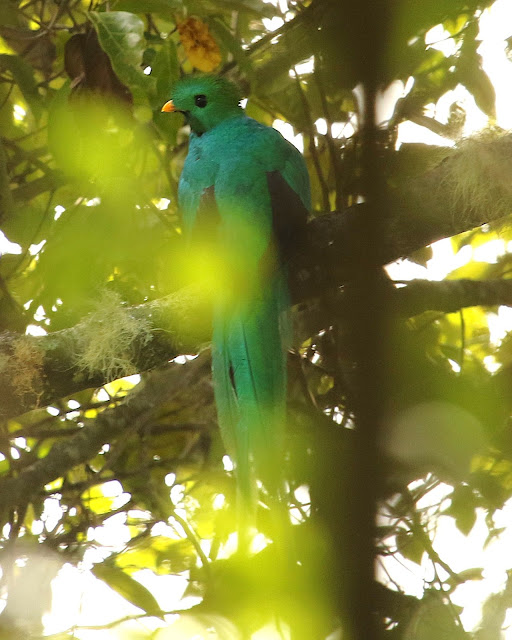 |
| Resplendent Quetzal - PN Los Quetzales, Costa Rica |
 |
| Golden-headed Quetzal - Angel Paz reserve, Ecuador (2014) |
Research has been done on trogon phylogeny (essentially their family tree) based on DNA evidence, which suggests an American - and specifically Central American - origin to the family (Moyle, 2005; Dacosta and Klicka, 2008). This would require these somewhat non-mobile birds to have crossed the Atlantic at some point, possibly through North America and over a land bridge: a‘high latitude dispersal event’ as Moore puts it. Which begs the question as to whether suitable conditions have ever existed to enable this movement. Could some weird trans-Atlantic rafting have happened instead? It seems unlikely, but such journeys have probably occurred for some plant and reptile species.
Despite its fame, the Resplendent Quetzal is a conservation concern, being classed as 'near threatened' by the IUCN. The main threat, as with so many species, is habitat loss, although this is less of a problem in Costa Rica's protected forests. Direct exploitation for its fabulous plumes may be decreasing, but a new concern has arisen from the range expansion of Keel-billed Toucans. The toucans compete for nest holes and can even prey on the nests of quetzals. Resolving the competing demands of two charismatic species can be a real headache for conservation land managers!
 |
| Keel-billed Toucan - competing with the Resplendent Quetzal for nest sites |
Right - two more birds to go. What could possibly beat the Resplendent Quetzal? Wait and see.
References:
BirdLife International. 2023. Pharomachrus mocinno. The IUCN Red List of Threatened Species 2023: e.T22682727A221577625. https://dx.doi.org/10.2305/IUCN.UK.2023-1.RLTS.T22682727A221577625.en.
DaCosta, J.M. and Klicka, J. (2008). ‘The Great American Interchange in birds: a phylogenetic perspective with the genus Trogon.’ Molecular Ecology, 17(5), pp.1328-1343.
Moyle, R.G. (2005). ‘Phylogeny and biogeographical history of Trogoniformes, a pantropical bird order.’ Biological Journal of the Linnean Society, 84(4), pp.725-738.
 |
| White-collared Manakin getting to grips with a rainforest seed or fruit. |
All of the photos in this blog post are of a male bird. Within the family as a whole, which contains some fifty species, the males are the showy ones with a dazzling range of colours - yellows, reds, blues, oranges and more. Females are generally more subdued, with a palette of dull greens and browns. As a result, identifying female manakins of different species can be tricky. Such a colour discepancy between the sexes (the technical term is sexual dichromatism) provides a hint aboout their respective life strategies: males display to attact females and mate, but do very little else, while it is the females that make the nest, incubate the eggs and feed the young. No comment!
Mind you, the males put a lot of effort into enticing a mate. The White-collared Manakin has a neat courtship dance which we were able to observe easily at Tirimbina biological reserve (website link here) because the male concerned was displaying next to the main entrance path. His stage was an area of forest floor, which he had partially cleared, dotted with a number of conspicuous vertical stems. Perching on a low branch, he made a loud buzzing sound followed by dramatic pops or snaps like the sound of a breaking twig. These are produced by vibrating the wings; making mechanical noises in addition to their vocalisations is a key manakin trait. (Have a look at this video showing the extraordinary display and sound of Ecuador's Club-winged Manakin, for example.)
Every now and again our male would fly sideways to sit at the base of another stem and repeat the process, sometimes zipping back and forth rapidly between perches. The following two pictures were an attempt to capture some manakin movement.
 |
| White-collared Manakin - ready for launch |
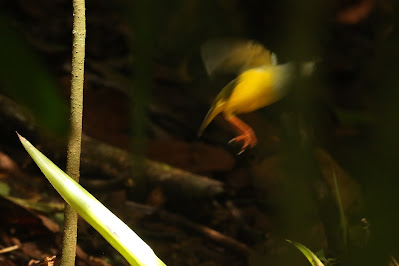 |
| White-collared Manakin - airborne |
(Apologies for the quality of the second image. The light was poor and the bird moved fast.)
We watched entranced, as the busy male buzzed from side to side. It wasn't obvious whether his efforts were being appreciated, although we had seen a female earlier nearby - an olive-green bird with vibrant orange legs - so her presence may have prompted the show. But the females can sometimes be hard to spot during the courtship process until they make their selection.
The White-collared Manakin's dance is spectacular, and worthy of being filmed - something that didn't occur to me at the time (but we had more birds to find of course!). However, there are a number of examples available online - such as this short YouTube video by Arnon Dattner from another forest reserve in Costa Rica. Enjoy, with the sound on.
I have watched manakins displaying in other Neotropical forests, including the closely-related White-bearded Manakin at the Asa Wright reserve on Trinidad. In that case, a number of manakins had gathered at the lek site, although they weren't particularly mobile. ("Lek" is a name given to both the place where males come to display and the displaying process itself.) But at Tirimbina, our White-collared Manakin male seemed to have the stage to himself. I'm hoping that his efforts weren't in vain.
Right - just three birds to go. What will be in the top three? And which bird merits the number one spot?
%2025.10.24.JPG) |
| Bare-shanked Screech Owl - near Irazu, Costa Rica |
While toucans, hummingbirds, motmots and the like grab all of the attention, most of the birds that people actually see in Costa Rica, and the rest of the Neotropics, will be from the vast order of Passerines - the perching birds. Of these, there are several dominant groups and families that are unique to the Americas, including tyrant flycatchers, antbirds, ovenbirds, tanagers and New World warblers. The Collared Redstart Myioborus torquatus, also known as the Collared Whitestart (I'll come back to this), belongs to the last of these families. But it is perhaps not a typical warbler.
In the USA, I've found warbler identification challenging - to say the least. Travelling in fall makes matters worse; a lot of species look very similar. And it's not just me, I'm pleased to say - see this handy identification guide from McGill University, for example. I was always aware that many of these birds are seasonal migrants, heading down to the Central and South America in the winter months. But until my visit to Costa Rica in October 2024 I had no idea of the scale of such movements. The Costa Rican rainforests seemed to be teeming with arrivals from the north. Tennessee, Chestnut-sided and Wilson's Warblers seemed to have the biggest numbers. It turns out that over three quarters of Costa Rica's warbler species are North American migrants. Most will stay for the winter, but a few like the Canada Warbler are simply passing through.
Not so the Collared Redstart, which is one of the much smaller group of Costa Rican resident warblers. Like the Talamanca Hummingbird (previously featured here), it is a range-restricted species that is only found in the mountains of Costa Rica and western Panama. Like the hummingbird it avoids the lower levels, with a minimum elevation of around 1,500 metres, although our first encounter was at higher altitude in the forests of southern Costa Rica's Dota Valley (below). We had come across a mixed flock passing through the trees, one of the most exciting - and frustrating - experiences in Neotropical birdwatching. Suddenly there is activity everywhere, and you don't quite know where to look. There are glimpses of birds moving through the vegetation, and nothing seems to stay still long enough to allow a decent view, let alone a photograph. A Collared Redstart flitted past me at that moment, showing its bright yellow colours nicely in flight. But then it was gone. Fortunately (as you will have guessed from the images in this blog post) we were able to get a better look at another later that day.
 |
| Rainforest - Dota Valley, Costa Rica |
The Dota Valley is well-trodden birding territory, but our guide (the indefatigable Pat O'Donnell - website here) knew of a quieter spot nearby. This is the largely unsurfaced road that leaves the Pan-American Highway and winds down a neighbouring valley towards Providencia. The road passes through an area of mature forest in the Parque Nacional Los Quetzales. Another bird is clearly the main attraction here of course - but will it appear in my Top Ten? Wait and see!
Anyway, after a tortilla-heavy stop for lunch from a roadside cafe, we started to look for birds, part-walking and part-driving down through the forest. The road wasn't quite as steep as the signs suggested, though:
 |
| Check your brakes! |
The time just after lunch can be quiet for birds, and today was no exception. But a few clouds rolled in, and this respite from the strong sunshine prompted some avian activity. Movement in the roadside bushes turned out to be a Lesser Goldfinch, followed (joy of joys) by a Collared Redstart that - this time - was happier to remain in one place, giving great views of its yellow face and neat chestnut cap.
%2024.10.24.JPG) |
| Collared Redstart - Parque Nacional Los Quetzales, Costa Rica |
At least there is no dispute that it has a collar, seen nicely in my final image:
Everybody likes a motmot. Brightly coloured, with distinctive racquet-shaped tails, motmots are easily recognisable birds. It helps that they are ambush hunters that can perch out in the open to get a better view of potential prey, which may be an unfortunate passing butterfly or small reptile. While motmots can sit in the same place for several hours, they can also be tempted out by an offer of free food and often visit fruit feeding stations set up by cafes and hotels - which in turn lure in birders and wildlife photographers.
The Blue-diademed Motmot, known locally as Lesson's Motmot, is the most common and visible Costa Rican motmot, although it is absent from the Caribbean foothills and lowlands in the north and east of the country. Being widespread in the Central Valley, Costa Rica's main population centre as well as being the start and finish of almost all birding trips, it should have been no trouble to locate on our recent trip. But we arrived at San Jose airport in total darkness, and left the Central Valley before light the following morning, so it wasn't until we returned almost two weeks later that we were able to 'bag' the motmot.
And it wasn't difficult to find. Our hotel (Villa San Ignacio, Alajuela - website here) has extensive grounds that include a small remnant of the rainforest that originally covered this part of the Central Valley. A trail gives access to guests, and it was while walking along this that we spotted the motmot perched high in a tree. As I was about to press the camera shutter the bird flew: don't you just hate it when birds do that? It's almost as if they have a 'sixth sense' that knows when a lens is pointing their way. Fortunately, we were able to catch up with another at the hotel's feeding station nearby.
%2026.10.24.JPG) |
| Blue-diademed (or Lesson's) Motmot - Villa San Ignacio, Alajuela |
 |
| Turquoise-browed Motmot - Punta Morales, Costa Rica |
You might reasonably argue that there is little difference between a 'blue diadem' and a 'turquoise brow'. But if you see the bird in good light, the flash of colour above the eye of the Turquoise-browed Motmot is really something special. It seems to almost shine with its own illumation. Turquoise-browed Motmots have a lighter body colour - somewhere between buff and a dull orange - and longer bare tail shafts than Blue-diademed (compare the photos above). Within Costa Rica, they are only found in the drier forests of the north Pacific lowlands, although their global range extends north through Nicaragua to Mexico's Yucatan peninsula. We caught up with the one pictured above near the coastal salt pans of Punta Morales, a place teeming with waders, terns, skimmers and other waterbirds. Not many birders come this way - but they certainly should. Finding places like this was one of the many advantages of having a locally-based guide, in our case the excellent Patrick O'Donnell - link to his website here.
But in the end, I decided to stick with the Blue-diademed Motmot for my list. It's a stunning bird that is easily seen and will likely feature on the camera rolls of even non-birdy visitors to Costa Rica. If that can draw more people into the magic that is Neotropical birdwatching then it's surely a good thing.
%2023.10.24.JPG) |
But the Talamanca Hummingbird Eugenes spectabilis is a good call. It's very much a range-restricted species, being only found in the mountains of Costa Rica and Western Panama (the Cordillera de Talamanca) above 2,000 metres altitude. It is a species that visiting birders will want to track down. Although not rare, you need to travel to find it.
Formerly called the Magnificent Hummingbird (more on this below), the large and long-billed Talamanca Hummingbird is certainly magnificent in appearance. Like many hummingbirds, the colours are not formed by pigments, but are instead created by the diffraction of light through structures in the feathers. This means that the birds can look very different with a change in viewing conditions. Beautiful though the images in bird guides may be, they can never do it full justice. The photograph at the start of this blog of a perched male Talamanca Hummingbird shows two of its main identification features - the white spot behind the eye and the iridescent turquoise throat. But it is missing a third key feature. To see it, look at what happened when the same bird turned to face the camera:
%2023.10.24.JPG) |
| Talamanca Hummingbird - showing violet crown and turquoise throat |
%20at%20feeder%20Myriam's%20(CR)%2024.10.24%20edit.JPEG) |
| Female Talamanca Hummingbird at a feeder |
 |
| Miriam's Quetzals cafe |
 |
| Great Tinamou - Tirimbina, Costa Rica |
The Great Tinamou Tinamus major is a direct opposite to the first bird in this series - the Blue-throated Toucanet (blog post here). Tinamous are reclusive, rather than conspicuous, and their colours are muted instead of showy. While the Blue-throated Toucanet is restricted to a small area of Central America, the Great Tinamou ranges across much of the Neotropics - see the GBIF distribution map here. So, why is it on my list?
Well - while tinamous are relatively common birds, this doesn't mean that they are easy to see. Several years ago, I spent two weeks exploring the forests of Ecuador without even a glimpse, even though we heard a few calling away in the undergrowth.
So a close encounter with a Great Tinamou in Costa Rica's Tirimbina rainforest reserve was one of the highlights of my trip. And the circumstances of that encounter will be very familiar to anyone who has birded the rainforests of the Neotropics.
We had come across a swarm of army ants moving through the forest. For most forest invertebrates, these swarms are lethal. Anything in their path gets despatched swiftly, and they'll even have a go at a human who is inadvertently standing in their path. The ants aren't just on the ground; they also climb onto low and medium height bushes and trees, passing through the rainforest at multiple levels. Potential prey has to get out of the way quickly, and the swarm's movement is accompanied by the sound of a gentle pattering, like rain. This is the sound of bugs and other insects dropping onto the forest floor in a bid to escape a grisly fate. It rarely works: more ants will be down there waiting for them.
%2018.10.24.JPG) |
| Army Ant column - Tirimbina rainforest reserve |
The chance to pick up an easy meal is what attracts a suite of birds - known as ant-followers - to these swarms. The Neotropics contain a wide range of these. But to correct a common misconception, these antbirds, antshrikes and their companions are not seeking to feed on the ants themselves. It is those displaced insects that draw them in. At Tirimbina, the Great Tinamou was one of a number of birds following the ant swarm, the others being Plain-breasted and Northern Barred Woodcreepers, Spotted and Ocellated Antbirds, an Olive-backed Quail-Dove (itself a star sighting) and a pair of Black-throated Trogons (female pictured below). Find an ant swarm and you will find the birds! A Central American Agouti briefly showed up as well, although it may just have been wondering what all of the fuss was about.
%20Tirimbina%2018.10.24.JPG) |
| Black-throated Trogon - another ant-follower at Tirimbina |
Tinamous are unusual birds. Although looking like grouse and similar gamebirds, they are more closely related to the ratites, the group that includes Ostriches and Rheas. Like Ostriches, the males incubate eggs and look after young chicks in their early days. But unlike those families, tinamous can fly, albeit not very well. They can't run particularly fast either, so their defensive strategy relies upon camouflage. This explains why birders find them so hard to see. Unfortunately, a cryptic lifestyle hasn't prevented tinamous from being a target for hunters. As such, your best chance of seeing one is in a protected forest. Which brings me back to Costa Rica in general, and Tirimbina in particular.
 |
| Tirimbina Rainforest Reserve - bridge over the Sarapiqui River |
%2018.10.24.JPEG) |
| Black Witch Moth - Tirimbina toilets |
%2018.10.24.JPG) |
| Fasciated Tiger-Heron - Tirimbina |
 |
| Mantled Howler Monkey - Tirimbina |
 |
| Central American Spider Monkey - Tirimbina |
 |
| Departing Great Tinamou |
%2019.10.23.JPG) |
| Blue-throated Toucanet |
Inevitably, this is a personal choice. I've adopted three general themes: birds with a story to tell, birds that are range-restricted and, most importantly, birds that have the elusive 'wow factor'. Not all of the ten birds will tick all of these boxes, but - hey - it's my list, so I can make the rules!
But before I get going I must give a huge shout out to Patrick O'Donnell, who guided us around the country for a couple of weeks, taking us to some sites that will be very familiar to visiting birders, and a few that won't be. Apart from being very patient, Pat is an absolute authority on where to find birds in Costa Rica - in fact, he literally wrote the book! He has written his own blog about our trip (link here). You can buy his book here.
Toucans are high on the wish-list of even non-birding tourists visiting Costa Rica. Two species are widespread across the country and easily seen - Yellow-throated Toucan Ramphastos ambiguus and Keel-billed Toucan Ramphastos sulfuratus (both pictured below). Of the two, Keel-billed Toucan is both the most visually striking, and the more range-restricted - being limited to Central America and northern Colombia. It is absent from Costa Rica's southern Pacific lowlands. Yellow-throated Toucan has a wider distribution, extending south into Peru; I've previously seen the species in Ecuador. You won't find it on Costa Rica's north Pacific coast, though. It is also called Black-mandibled Toucan in the essential 'Birds of Costa Rica' by Richard Garrigues and Robert Dean, even though the bill is more of a chestnut colour than black.
 |
| Yellow-throated Toucan |
 |
| Keel-billed Toucan |
However, I have chosen a rather more localised - and arguably more spectacular - species for my Top Ten. The Blue-throated Toucanet is a bird of Costa Rica's uplands, specifically the middle elevations between around 700m and 2400m. Our first encounter with the species (photo below) was at Pocosol Biological Station, which sits in protected primary rainforest (the Bosque Eterno de los Niños, or Children's Eternal Rainforest - its purchase was funded by global childrens' donations) to the east of the more popular Monteverde area. This was a good chance to see the species in an entirely natural setting. Pocosol sits at an elevation of around 720m above sea level and is located at the end of a long, and at times challenging, access track. 4WD is probably recommended, but it's worth the effort.
 |
| First sighting of Blue-throated Toucanet at Pocosol, Costa Rica |
 |
| Pocosol Biological Station |
 |
| Blue-throated Toucanet - Cinchona cafe, Costa Rica |
 |
| The Soda y Mirador Cinchona |